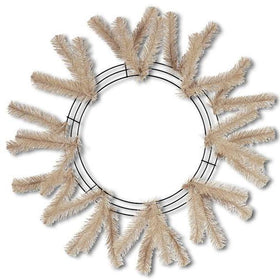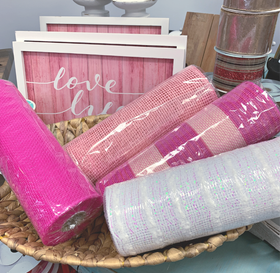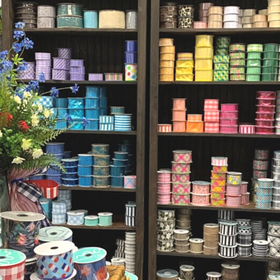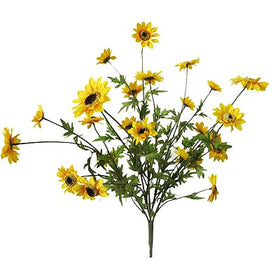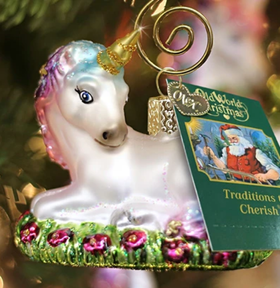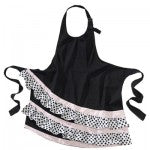
RAZ Polka Dot Apron
The new aprons of today are not my grandmother's apron. My grandmother's apron was mostly made of feedsack or other inexpensive cotton material. Most were just fabric gathered on to a waist band with pockets and ties. Left over odds and ends materials would be used. Sometimes there would be a bib. I don't recall my mother wearing an apron, she was a bit of a maverick. She was more likely to throw on one of my daddy's shirts as a cover up.
The apron protected her clothing which was most always a dress. My grandmother rarely wore pants or jeans when I was young (1950's). But she did have a pair of jeans that she wore when we went blackberry picking or fishing.You had to protect yourself when blackberry picking or you would be "eat up by chiggers." For real....no kiddin....
The apron was used for wiping off or drying hands, getting hot pans out of the oven or off the stove and wiping dirty faces of grandchildren. No nose blowing on it though! She had a handkerchief in her pocket for that. The apron was put on first thing in the morning and not taken off until bath time at night. Some aprons were for "everyday" some were for Sundays and holidays. The Sundays and holiday aprons didn't have a Christmas look or anything, just maybe nicer fabric or newer.

Feed sack material was used for making aprons, pillowcases, quilts, dish towels, dresses, bonnets and all sorts of things. Cow feed was purchased in big 100# bags from a nearby country store. Wayne Feeds was the product available in our area I suppose. Everyone had a Wayne Feeds sign on their barn.

It was always fun to see what the bags looked like when being unloaded off the pickup. There were always ooohhs and ahhhhhs.....this would make a pretty quilt......that one for a bonnet.......maybe even a night gown.
Enough sacks of the same style might be enough material to make a dress. There was one child sized night gown made of feed sack that stayed at my grandmother's house for anyone who needed it. Then one day, a new pink nylon gown showed up. It happened to be just about my size))) It's not very pink anymore, but I still have it in the bottom of my lingerie drawer. Sleeping over was a routine thing. Every weekend. Either Friday or Saturday night. Always.
I never saw my grandmother use a pattern to make anything. She just spread the material out on the table or bed and started cutting. My mother was the better seamstress and would sometimes make a pattern from newspaper or use bought patterns from Simplicity, McCalls or Butterick. She never pinned the fine tissue pattern pieces down, just laid dinner knives around the pieces as weights and cut away.
Sewing was done on my grandmother's treadle machine. My mother used a treadle machine, but traded up for an electric one. I was making some of my own school clothes by the 5th grade or so. I remember starting out making doll clothes, then

Not my grandmother's, but similar
taking my older sister's clothes and taking in the side seams, hems and shoulder seams. I can't believe my mother actually let me wear those things!
Feedsack material was used to make quilts. I never participated in a "quilting bee" or anything like that, but I did practice my sewing on "piecing quilts." If anything I ever sewed together ever made it into a quilt, I don't know. I think it was mostly to give me something to do. The quilts we had at home were "everyday" quilts. Quilts pieced together with large strips or squares of feedsack material, batting was thick and the underneath side was "plain" feedsack.

These quilts were not made to be pretty, they were made to keep us warm. It was not uncommon to sleep under several layers of quilts. The cover would get so heavy you could hardly move. My grandmother had everyday quilts, and also her "good" quilts. The "good" quilts were kept stored between the mattresses. She didn't have a cedar chest or blanket chest. Every so often she would take the "good" quilts out and show them to us, me and my sisters. She would talk about which one would go to who and so on. They would be taken out for airing from time to time, but never used. She always promised us one when we got married, but we couldn't use it, we had to take care of it. And so, we all got our quilts. And, I did just like she said. I put mine in a plastic zip cover and put it up for safe keeping.

I took my "good" quilt out to photograph for this blog and as my 7 year old granddaughter admired it, she asked if she might have it some day. I said yes of course, that she could have it someday.
But that she'd have to put it up and take care of it......well.....what would have have said??? We're going on 100 years with this quilt and I don't think one person has slept under it yet!
I've seen lots of pictures of ladies in frilly aprons from the 1950's but I don't recall seeing anyone wear aprons like those. Mostly the dressy aprons I remember were pictures in advertisements, etc. I guess using an apron to keep your dress clean and changing it everyday was much easier and cut down on the laundry of the dresses. Laundry wasn't exactly an easy thing to my recollection.

My mother and grandmother both had electric washing machines. They only agitated the clothes but they had an automatic wringer that you manually threaded the clothes through. My mother's machine was located out in the "milk room" of the barn. It's not the one in the photo, but was similar. There was hot water in the milk room, but not piped to the washer. She had to fill up buckets of hot water and pour into the washer. After the clothes had washed they would be run through the ringer by hand and over into the large basin where milking equipment was washed. I remember the warnings about getting fingers caught in the wringer. Clothes were rinsed, put back through the wringer again and then hung out on the clothes line to dry. My grandmother's washer was in the smokehouse. She carried the hot water to the washer either from the house or the milk barn.
I don't remember my mother using an outside "wash pot", but I've seen my grandmother do it. A fire was built and large black cast iron pot was filled with water. Slivers of homemade lye soap were added to the water and my grandfather's work clothes were put in. A long stick was used to push the clothes down in the water, stir around and pull out of the water after a while. Bedclothes were occasionally washed this way too. The clothes would be steaming and then placed in a pot of cold water for rinsing. And we get frustrated sometimes when we have to gather up a load of clothes, through in the washer and push a button.....pitiful aren't we))
Samples of feedsack material used in quilts:

feedsack fabric
I love this pattern. It's a girl, washing, and shows clothes hanging on the clothes line. I doubt very seriously you would have seen this same print with a boy doing the washing!
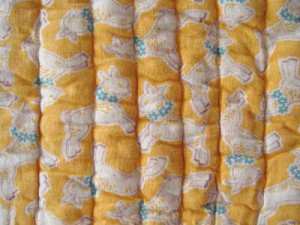
This pattern has little lambs, or maybe goats with flowers around it's neck. It's amazing that the cheap feedsack material has retained this much color.

Plain feedsacks were used for quilt backing, sheets, pillowcases, dish towels and more. We never had to wear underwear made of feedsack, but my mother and grandmother did. This photo is the backing of the "everyday" quilt pictured above. The "good" quilt had a much nicer backing. All one solid color piece, smoother material. Must have been a purchased piece of fabric just for the quilt. If anyone has any idea what the pattern was of my "good" quilt, I'd sure like to know.
The apron was used as a shopping bag of sorts. A trip to the garden meant digging up new potatoes or "arsh" potatoes with a fork and holding them in the apron on the way back to the house. A bucket was used if you were getting enough vegetables to can but the apron was used when you were just going to the garden to get a "mess" of something. The apron held eggs gathered from the chicken house, apples from the "June" apple tree, strawberries from a corner in the garden (we always had them in a glass of milk) and just about anything else grown in the garden - onions, peas, corn, butter beans, green beans, cabbage, peppers, etc. Sometimes she would dip into a pillowcase hanging on the back porch filled with dried apples or peaches and put a few handfuls in her apron to make fried apple or peach pies. That's material for a whole other blog))
So, the aprons of today look a little different but still serve the same purpose. I don't wear one everyday, but when I'm in the kitchen fixing a big meal, I put one on..sometimes. And I have a couple that I actually made. But I made mine because of boredom at some point or having some free time. That was a few years ago.
Many aprons today are fashioned after the old 1940-1950's aprons. Even fabrics are chosen to mimic the old cheap feedsack material. Aprons can be purchased all over the Internet from $10 to $50 or more. We have several styles right here on Trendy Tree for sale.
I may put my apron and wear it for this afternoon while I'm cooking, but it's not like I'm going to be running out to the garden to dig potatoes with a fork for supper tonight!

